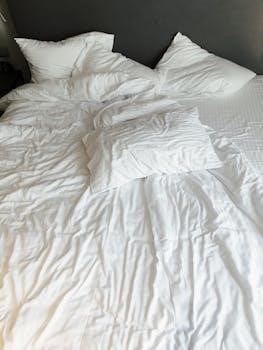
Intex Blow Up Bed Instructions⁚ A Comprehensive Guide
Welcome! This comprehensive guide provides detailed instructions for your Intex blow-up bed, ensuring proper setup, use, and maintenance․ Follow these instructions to maximize comfort, safety, and the lifespan of your Intex air bed․
Understanding Your Intex Air Bed
Before diving into the setup, it’s crucial to understand the key features of your Intex air bed․ Intex offers various models, from basic to premium, each with unique characteristics․ Many incorporate Fiber-Tech construction for enhanced support and durability․ Some come with built-in electric pumps for convenient inflation, while others require external pumps․ Knowing your model’s specifics ensures proper handling and avoids potential issues․
Familiarize yourself with the air valve type, whether it’s a simple stopper or a more complex mechanism․ Locate the inflation and deflation ports․ Check for included accessories like a carry bag, repair patch, or instruction manual․ The manual contains vital information, including safety precautions and troubleshooting tips․
Understanding the materials used is also essential; Most Intex air beds are made from durable PVC, but knowing the specific type helps when cleaning or repairing․ Remember, proper care extends the life of your air bed, providing comfortable sleep for years․ Finally, always review the weight capacity to prevent damage and ensure optimal performance․ This initial understanding sets the foundation for a positive experience․

Initial Setup and Inflation
Proper setup is crucial for comfort and longevity․ This section covers locating a suitable space, unpacking, inspection, and inflation methods using both built-in and external pumps․ Follow these steps for optimal results․
Locating a Suitable Space
The first step in setting up your Intex air bed is choosing the right location․ Selecting a proper space is crucial for comfort, safety, and the longevity of your inflatable mattress․ Begin by identifying a flat, level surface․ Uneven surfaces can cause instability and discomfort, potentially leading to a restless night’s sleep․
Clear the area of any sharp objects or debris․ Small stones, splinters, or other items can puncture the air bed, causing leaks and rendering it unusable․ Ensure the space is free from anything that could damage the material․
Consider the proximity to power outlets if you plan to use an electric pump, whether built-in or external․ An easily accessible outlet will simplify the inflation process․ Also, check for enough room around the bed, allowing easy movement and preventing accidental bumps into walls or furniture․
Avoid placing the air bed near heat sources such as radiators or open flames․ Excessive heat can damage the material and pose a safety hazard․ Finally, ensure the room is well-ventilated to prevent moisture build-up, which can lead to mold or mildew․ A clean, dry, and spacious area will provide the best experience with your Intex air bed․
Unpacking and Inspection
After identifying a suitable space, carefully unpack your Intex air bed․ Remove it from the packaging and lay it out on the prepared surface․ Take care not to use any sharp objects when opening the box, as these could accidentally puncture the mattress․
Once unpacked, thoroughly inspect the air bed for any signs of damage․ Check for tears, punctures, or abrasions in the material․ Pay close attention to the seams and edges, as these are common areas for defects․ If you find any damage, do not attempt to inflate the bed․ Contact Intex customer service for assistance or a replacement․
Ensure that all included components are present․ This typically includes the air bed itself, any built-in pump accessories, and a repair patch kit․ Some models may also come with a carrying bag for storage․ Consult the user manual to verify the complete list of components․
Familiarize yourself with the location of the inflation valve or pump․ This will help streamline the inflation process․ If your air bed has a built-in pump, locate the control dial or switch․ Read the instructions in the manual regarding the pump’s operation․ This initial inspection will help prevent issues and ensure a smooth setup․
Inflation Using the Built-in Pump
If your Intex air bed features a built-in electric pump, the inflation process is relatively straightforward․ Begin by ensuring the air bed is laid out flat on a clear surface, free from any sharp objects or obstructions․ Locate the control dial or switch for the built-in pump․ This is usually located on the side of the air bed․
Plug the pump’s power cord into a standard electrical outlet․ Make sure the outlet is easily accessible and that the cord is not stretched or strained․ Before turning on the pump, double-check that the deflation valve is securely closed․ This will prevent air from escaping during inflation․
Turn the control dial or flip the switch to the “inflate” position․ The pump will begin to inflate the air bed․ Monitor the inflation process closely․ Avoid over-inflating the bed, as this can damage the seams and reduce its lifespan․ The air bed should feel firm but not overly rigid․
Once the air bed reaches the desired firmness, turn the control dial or switch back to the “off” position․ Unplug the pump from the electrical outlet․ Some models may have an automatic shut-off feature to prevent over-inflation․ Refer to your user manual for specific details about your model’s features․
Inflation with an External Pump (Manual or Electric)
For Intex air beds without a built-in pump, you’ll need to use an external pump, either manual or electric․ First, locate the air valve on your air bed․ Ensure the valve is clean and free from any debris that could obstruct airflow․ Open the valve cap to prepare for inflation․
If using an electric pump, attach the appropriate nozzle to the pump’s hose․ The nozzle should fit snugly into the air valve to prevent air leakage during inflation․ Plug the pump into a power outlet and turn it on․ Monitor the inflation process closely, avoiding over-inflation․ The bed should feel firm but not overly tight․
For manual pumps, attach the hose to the pump and the appropriate nozzle to the other end of the hose․ Insert the nozzle into the air valve and begin pumping․ Manual inflation requires more effort and time than electric pumps․ Take breaks as needed and continue pumping until the air bed reaches the desired firmness․
Once inflated to the desired level, quickly remove the pump nozzle and securely close the air valve cap to prevent air from escaping․ Double-check the valve to ensure it is properly sealed․ The air bed is now ready for use․ Remember to always follow the pump manufacturer’s instructions for safe operation․

Deflation and Storage
Proper deflation and storage are crucial for extending the life of your Intex air bed․ Follow these steps to efficiently deflate, fold, and store your air bed correctly for future use․
Deflating the Air Bed
Deflating your Intex air bed properly is essential for compact storage and preventing damage․ Whether you have a built-in pump or use an external one, the deflation process is straightforward․ First, locate the deflation valve․ For beds with a built-in pump, this is often the same valve used for inflation, but with a reverse setting․ Ensure the area around the valve is clear of obstructions․
If using the built-in pump, switch the control dial to the deflate setting․ The pump will begin to extract air from the mattress․ Allow the pump to run until the air bed is mostly deflated․ For air beds inflated with an external pump, open the valve and allow the air to escape naturally․
To expedite the process, you can gently press down on the air bed to help push the air out․ Be careful not to apply excessive force, which could damage the internal structure․ Once most of the air is removed, you can use an external pump on the deflate setting, if available, to remove any remaining air․ Ensure the bed is as flat as possible before proceeding to folding and packing․
Folding and Packing for Storage
After completely deflating your Intex air bed, the next crucial step is proper folding and packing for storage․ This process helps prevent damage and ensures the bed remains in good condition for future use․ Start by laying the deflated air bed on a clean, flat surface․ Smooth out any wrinkles or creases to ensure an even fold․
Begin folding the air bed lengthwise into thirds, bringing one side over towards the middle, and then the other side over to meet it․ This creates a long, narrow shape․ Next, start rolling the bed tightly from one end to the other, pressing down gently to expel any remaining air․ The goal is to create a compact roll that fits easily into the storage bag․
Once rolled, secure the air bed with straps or ties if available․ This prevents it from unrolling during storage․ Carefully place the rolled air bed into the provided storage bag․ Ensure the bag is not too small, as forcing the bed inside can cause damage․ Store the packed air bed in a cool, dry place, away from direct sunlight and extreme temperatures․
Proper Storage Conditions
Maintaining proper storage conditions is vital to prolonging the life of your Intex air bed; The environment in which you store your air bed can significantly impact its material integrity and overall usability․ Avoid storing the air bed in areas exposed to extreme temperatures, such as attics or garages, where heat can degrade the PVC material, leading to leaks and weakening․
Similarly, avoid storing it in damp or humid environments like basements, as moisture can promote mold and mildew growth, damaging the bed and causing unpleasant odors․ The ideal storage location is a cool, dry, and clean place, such as a closet shelf or under a bed, where temperatures are stable, and humidity is minimal․
Ensure the storage area is free from sharp objects or abrasive surfaces that could puncture or scratch the air bed․ Before storing, double-check that the air bed is completely dry to prevent any moisture-related issues․ Following these storage guidelines will help keep your Intex air bed in excellent condition․

Safety Precautions and Maintenance
Prioritize safety and regular upkeep to extend your Intex air bed’s life․ This section covers crucial warnings, cleaning tips, and troubleshooting for common problems, ensuring a safe and well-maintained inflatable bed․
Important Safety Warnings (Infants, Flammables)
Infant Safety⁚ Never place infants aged birth to 15 months on inflatable air mattresses or beds․ Air beds pose a suffocation risk to infants․ Always use a firm, flat surface designed for infant sleep․ The edges of an air bed offer less support and increase the risk of a child rolling off․
Flammable Materials⁚ Keep the air bed away from open flames, heaters, and other heat sources․ Never introduce flammable substances, such as aerosols, into the air bed․ Such materials can ignite and cause serious injury or property damage․ Avoid smoking near the air bed;
General Safety⁚ Do not operate the air pump for more than 5 minutes continuously to prevent overheating․ Do not sleep on the edge of the air bed, as it provides less support than the middle․ Always supervise children when they are near the inflated air bed․ Avoid jumping or standing on the air bed, as this can cause damage or injury․ Ensure the area around the air bed is clear of sharp objects․
Cleaning and Maintenance Tips
Maintaining your Intex air bed properly will prolong its life and ensure a comfortable sleeping experience․ Regular cleaning is essential to prevent the buildup of dirt, dust, and allergens․ To clean the air bed, first deflate it completely․ Use a soft, damp cloth with mild soap to wipe down the surface․ Avoid using harsh chemicals or abrasive cleaners, as these can damage the material․
After cleaning, ensure the air bed is completely dry before storing it․ Moisture can lead to mold and mildew growth, which can damage the air bed and pose health risks․ To dry the air bed, you can use a clean, dry cloth or allow it to air dry in a well-ventilated area away from direct sunlight․
Regularly inspect the air bed for any signs of wear and tear, such as small punctures or leaks․ Repair any damage promptly using the provided repair patch or a suitable alternative․ Store the air bed in a cool, dry place away from direct sunlight when not in use․
Troubleshooting Common Issues (Leaks, Pump Problems)
Even with proper care, you may encounter issues with your Intex air bed․ Leaks are a common problem․ To locate a leak, inflate the bed and listen for hissing sounds․ You can also apply a soapy water solution to the surface; bubbles will form at the leak’s location․ Clean and dry the area around the leak before applying a repair patch․ Firmly press the patch onto the surface and allow it to dry completely before reinflating the bed․
Pump problems can also occur․ If the built-in pump is not working, check the power connection and ensure the outlet is functioning correctly․ For external pumps, ensure the hose is securely attached to both the pump and the air bed valve․ If the pump motor is running but not inflating, check for blockages in the hose or valve․
If the air bed loses air overnight, it may not necessarily indicate a leak․ Temperature changes can cause air to contract, resulting in a slight pressure decrease․ Inflate the bed slightly to compensate for this․ If the problem persists, re-check for leaks․